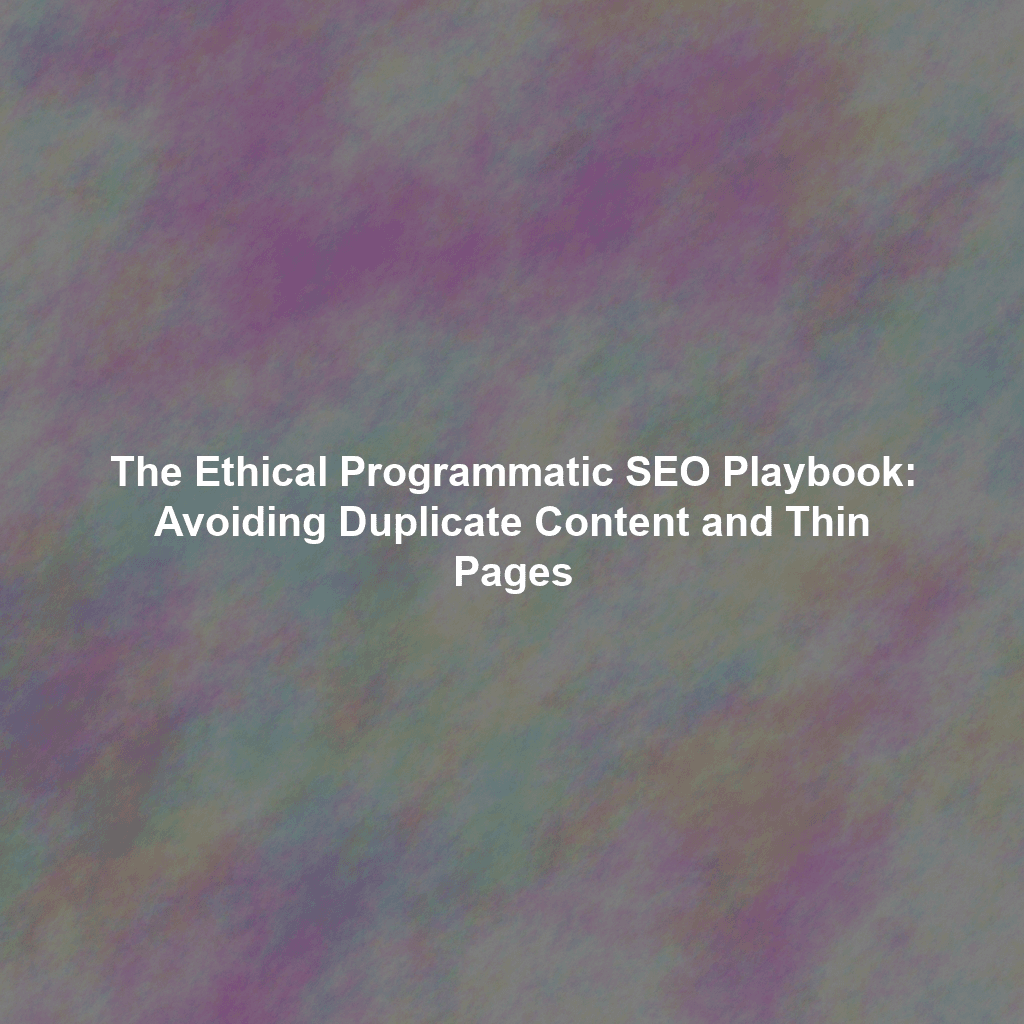Welcome to the world of Programmatic SEO, a strategy often hailed as the “lazy marketer’s” path to ranking. But, let’s be honest, achieving those rankings in 2025 and beyond requires more than just laziness; it demands a strategic and, most importantly, ethical approach. One of the biggest challenges with scaling content programmatically is avoiding the pitfalls of duplicate content and thin pages. This guide dives deep into how to navigate these murky waters and build a powerful, sustainable SEO strategy that Google (and, more importantly, your users) will love.
The Dark Side of Programmatic SEO: Duplicate Content and Thin Pages
The allure of generating hundreds or thousands of pages with minimal effort is strong. However, this often leads to pages that offer little unique value and are essentially copies of each other, differing only in minor details. Google sees this as an attempt to game the system, and the consequences can be severe – from ranking penalties to complete de-indexing.
What are Duplicate Content and Thin Pages?
- Duplicate Content: Content that is substantially similar to other content found on the web, either within your own site or across multiple domains. This doesn’t always mean plagiarism; even slight variations on a template can be flagged as duplicate content.
- Thin Pages: Pages that offer little or no value to the user. This could be due to a lack of original content, scraped content, or simply a page that doesn’t address the user’s query adequately. Think of a page that promises “best hotels in Paris” but only lists three with minimal details.
Why are They Bad for SEO?
Google’s algorithms are designed to provide users with the best possible search results. Duplicate and thin content undermine this goal by:
- Diluting Ranking Power: Instead of concentrating ranking signals on a few high-quality pages, you’re spreading them thin across many low-quality ones.
- Wasting Crawl Budget: Googlebot has a limited amount of time to crawl your site. If it spends time on low-value pages, it may miss important content.
- Hurting User Experience: Users quickly become frustrated when they land on pages that don’t deliver on their promise, leading to higher bounce rates and lower engagement.
The Ethical Programmatic SEO Playbook: Building Quality at Scale
So, how do you leverage the power of programmatic SEO without falling into these traps? The key is to prioritize quality and user experience above all else.
1. Embrace Data Enrichment
Your dataset is the foundation of your programmatic SEO strategy. Don’t just rely on basic information. Enrich your data with unique insights and added value.
- User Reviews and Ratings: Incorporate user-generated content to add depth and authenticity.
- Local Insights: Add information about the surrounding area, points of interest, or local events.
- Comparisons and Analyses: Provide comparisons between different options, highlighting their pros and cons.
2. Dynamic Content Personalization
Instead of serving static content, leverage dynamic content to tailor the user experience based on their location, search query, or past behavior. This requires a bit more technical sophistication, but the payoff in terms of user engagement and SEO is significant.
- Location-Based Customization: Show relevant information based on the user’s location.
- Query-Based Content: Adapt the content based on the specific keywords the user searched for.
- Personalized Recommendations: Suggest related products or services based on the user’s browsing history.
3. Content Spinning… Ethically!
Content spinning has a bad reputation, and rightfully so. However, when done responsibly, it can be a useful tool for creating variations of your core content. The key is to focus on meaningful rewrites and additions, not just superficial changes.
- Focus on Value-Added Rewrites: Don’t just change a few words here and there. Rephrase entire sentences and paragraphs to provide fresh perspectives.
- Add Unique Insights: Incorporate your own research, analysis, or opinions to make the content truly original.
- Use AI Writing Tools Wisely: AI writing tools can be helpful for generating content variations, but always review and edit the output to ensure quality and accuracy. Treat them as assistants, not replacements for human writers.
4. Leverage Canonical Tags and Noindex
Sometimes, despite your best efforts, you may end up with pages that are very similar. In these cases, use canonical tags to tell Google which page is the preferred version. For pages that offer little value, consider using the “noindex” tag to prevent them from being indexed altogether.
5. E-E-A-T: Experience, Expertise, Authoritativeness, and Trustworthiness
In the age of AI-generated content, Google is placing even greater emphasis on E-E-A-T. Your programmatic SEO strategy must demonstrate these qualities to gain trust and authority.
- Experience: Showcase your real-world experience by including case studies, testimonials, and examples.
- Expertise: Demonstrate your knowledge by providing in-depth explanations, data-backed insights, and references to reputable sources.
- Authoritativeness: Build a strong reputation by earning links from other authoritative websites in your industry.
- Trustworthiness: Be transparent about your sources, cite your data, and avoid making misleading claims. Ensure your website is secure (HTTPS) and has a clear privacy policy.
Programmatic SEO: The Lazy Marketer’s Ethical Guide to Ranking in 2025
Programmatic SEO offers a powerful way to scale your content efforts, but it’s crucial to do it ethically. By focusing on data enrichment, dynamic personalization, responsible content spinning, and E-E-A-T, you can avoid the pitfalls of duplicate content and thin pages and build a sustainable SEO strategy that delivers long-term results. Remember, the “lazy marketer” approach only works if you’re smart and strategic. Invest the time upfront to create high-quality content, and you’ll reap the rewards for years to come. In 2025, and beyond, E-E-A-T and unique value will be the ultimate ranking factors.
 Skip to content
Skip to content

